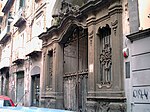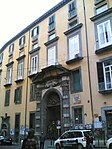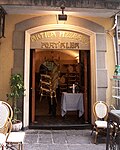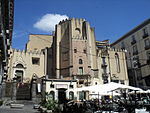Santa Marta, Naples
16th-century Roman Catholic church buildings in ItalyBaroque architecture in NaplesChurches in NaplesRenaissance architecture in Naples

Santa Marta is a Roman Catholic church located on Via Benedetto Croce (part of Spaccanapoli, in central Naples, Italy. It is located parallel to the convent of Santa Chiara, and stands in front of the Palazzo Filomarino della Rocca.
Excerpt from the Wikipedia article Santa Marta, Naples (License: CC BY-SA 3.0, Authors, Images).Santa Marta, Naples
Via San Sebastiano, Naples San Giuseppe
Geographical coordinates (GPS) Address External links Nearby Places Show on map
Geographical coordinates (GPS)
| Latitude | Longitude |
|---|---|
| N 40.847631 ° | E 14.252748 ° |
Address
Santa Marta
Via San Sebastiano
80134 Naples, San Giuseppe
Campania, Italy
Open on Google Maps










